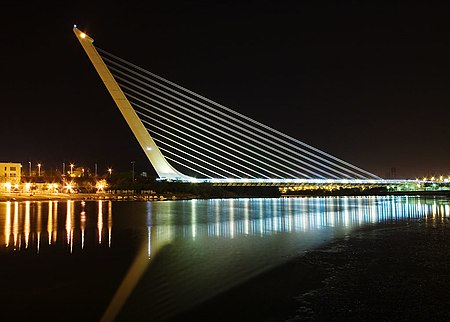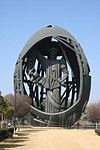Alamillo Bridge
Bridges by Santiago CalatravaBridges completed in 1992Bridges in SevilleBridges over the Guadalquivir RiverCable-stayed bridges in Spain ... and 5 more
Inclined towersNeo-futurism architectureSeville Expo '92Tourist attractions in SevilleWorld's fair architecture in Seville

The Alamillo Bridge (Spanish: Puente del Alamillo) is a structure in Seville, Andalucia (Spain), which spans the Canal de Alfonso XIII, allowing access to La Cartuja, a peninsula located between the canal and the Guadalquivir River. The bridge was constructed as part of infrastructure improvements for Expo 92, which was held on large banana farms on the island. Construction of the bridge began in 1989 and was completed in 1992 from a design by Santiago Calatrava.
Excerpt from the Wikipedia article Alamillo Bridge (License: CC BY-SA 3.0, Authors, Images).Alamillo Bridge
Paseo de Juan Carlos I, Seville Distrito Macarena
Geographical coordinates (GPS) Address External links Nearby Places Show on map
Geographical coordinates (GPS)
| Latitude | Longitude |
|---|---|
| N 37.413333333333 ° | E -5.9902777777778 ° |
Address
Puente del Alamillo
Paseo de Juan Carlos I
41071 Seville, Distrito Macarena
Andalusia, Spain
Open on Google Maps











